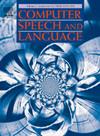Towards decoupling frontend enhancement and backend recognition in monaural robust ASR
IF 3.4
3区 计算机科学
Q2 COMPUTER SCIENCE, ARTIFICIAL INTELLIGENCE
引用次数: 0
Abstract
It has been shown that the intelligibility of noisy speech can be improved by speech enhancement (SE) algorithms. However, monaural SE has not been established as an effective frontend for automatic speech recognition (ASR) in noisy conditions compared to an ASR model trained on noisy speech directly. The divide between SE and ASR impedes the progress of robust ASR systems, especially as SE has made major advances in recent years. This paper focuses on eliminating this divide with an ARN (attentive recurrent network) time-domain, a TF-CrossNet time–frequency domain, and an MP-SENet magnitude-phase based enhancement model. The proposed systems decouple frontend enhancement and backend ASR, with the latter trained only on clean speech. Results on the WSJ, CHiME-2, LibriSpeech, and CHiME-4 corpora demonstrate that ARN, TF-CrossNet, and MP-SENet enhanced speech all translate to improved ASR results in noisy and reverberant environments, and generalize well to real acoustic scenarios. The proposed system outperforms the baselines trained on corrupted speech directly. Furthermore, it cuts the previous best word error rate (WER) on CHiME-2 by 28.4% relatively with a 5.6% WER, and achieves WER on single-channel CHiME-4 simulated/real test data without training on CHiME-4. We also observe consistent improvements using noise-robust Whisper as the backend ASR model.
单鲁棒ASR中前端增强与后端识别的解耦研究
研究表明,语音增强(SE)算法可以提高噪声语音的可理解性。然而,与直接在有噪声的语音上训练的自动语音识别模型相比,单耳SE尚未被建立为在有噪声条件下自动语音识别(ASR)的有效前端。SE和ASR之间的鸿沟阻碍了强大的ASR系统的发展,特别是在SE近年来取得重大进展的情况下。本文的重点是通过ARN(注意循环网络)时域、TF-CrossNet时频域和MP-SENet基于幅度相位的增强模型来消除这种鸿沟。所提出的系统将前端增强和后端ASR解耦,后者仅在干净的语音上进行训练。在WSJ、CHiME-2、librisspeech和CHiME-4语料库上的结果表明,在嘈杂和混响环境中,ARN、TF-CrossNet和MP-SENet增强语音都转化为改善的ASR结果,并且可以很好地推广到真实声学场景。所提系统的性能优于直接在损坏语音上训练的基线。此外,该算法将先前在CHiME-2上的最佳单词错误率(WER)从5.6%的WER降低了28.4%,在单通道CHiME-4上未经训练的模拟/真实测试数据上达到3.3/4.4%的WER。我们还观察到使用噪声鲁棒Whisper作为后端ASR模型的一致性改进。
本文章由计算机程序翻译,如有差异,请以英文原文为准。
求助全文
约1分钟内获得全文
求助全文
来源期刊

Computer Speech and Language
工程技术-计算机:人工智能
CiteScore
11.30
自引率
4.70%
发文量
80
审稿时长
22.9 weeks
期刊介绍:
Computer Speech & Language publishes reports of original research related to the recognition, understanding, production, coding and mining of speech and language.
The speech and language sciences have a long history, but it is only relatively recently that large-scale implementation of and experimentation with complex models of speech and language processing has become feasible. Such research is often carried out somewhat separately by practitioners of artificial intelligence, computer science, electronic engineering, information retrieval, linguistics, phonetics, or psychology.
 求助内容:
求助内容: 应助结果提醒方式:
应助结果提醒方式:


